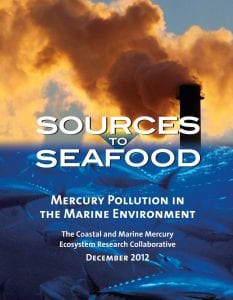Sources to Seafood report released
 In 2012, C-MERC authors published a series of scientific papers in the journals Environmental Research and Environmental Health Perspectives that elucidated key processes related to the inputs, cycling, and uptake of mercury in marine ecosystems, effects on human health, and policy implications. Sources to Seafood looks at the pathways and consequences of mercury pollution across marine systems by drawing on findings from the C-MERC papers, scientific literature and data from a range of marine systems and coastal basins. The report examines mercury sources, pathways, and inputs for the Hudson River Estuary, San Francisco Bay, Gulf of Mexico, Long Island Sound, Chesapeake Bay, Gulf of Maine, Arctic Ocean, and the open ocean.
In 2012, C-MERC authors published a series of scientific papers in the journals Environmental Research and Environmental Health Perspectives that elucidated key processes related to the inputs, cycling, and uptake of mercury in marine ecosystems, effects on human health, and policy implications. Sources to Seafood looks at the pathways and consequences of mercury pollution across marine systems by drawing on findings from the C-MERC papers, scientific literature and data from a range of marine systems and coastal basins. The report examines mercury sources, pathways, and inputs for the Hudson River Estuary, San Francisco Bay, Gulf of Mexico, Long Island Sound, Chesapeake Bay, Gulf of Maine, Arctic Ocean, and the open ocean.
Press Release
Report Summary
DC Briefings
Links to additional information
Environmental Research Special Issue
Environmental Health Perspectives Issue (2 papers and 1 editorial)
C-MERC Researcher Bios
Background on C-MERC
In 2010, the Toxic Metals Superfund Research Program at Dartmouth College brought together a group of 50 scientists and policy stakeholders to form C-MERC, the Coastal and Marine Mercury Ecosystem Research Collaborative. The goal was to review current knowledge – and knowledge gaps – relating to a global environmental health problem: mercury contamination of the world’s marine fish. C-MERC participants attended two workshops over a two-year period and in 2012, C-MERC authors published a series of scientific papers in the journals Environmental Research and Environmental Health Perspectives that elucidated key processes related to the inputs, cycling, and uptake of mercury in marine ecosystems, effects on human health, and policy implications.
The resulting 11 papers cover six ocean regions, consider the additional factors affecting mercury cycling in ocean systems, provide a discussion of the related policy, and discuss low level effects on human health and fish consumption advice. These papers are synthesized in the report Sources to Seafood: Mercury Pollution in the Marine Environment, which will inform policies being considered at regional, national, and global levels.
The Workshops
Two inter-related, invitational workshops (the first of which was held in Portsmouth, NH September 8-10, 2010 and the next in Halifax NS on July 23, 2011) allowed researchers and policymakers to gather and synthesize knowledge about mercury in marine systems, focusing on seven ocean systems and a range of emerging global mercury topics. The meetings were working sessions which included the development of questions from policymakers to be addressed as part of the development of the scientific synthesis papers on mercury in marine environments. Scientists involved with mercury deposition, biogeochemical cycling, trophic transfer, ecotoxicology, and human health related research connected with policy stakeholders from EPA, NOAA, FDA, industry and NGOs to examine the implications for human exposure, public health and related issues pertaining to national and global mercury policy.
Several C-MERC papers were included as part of a special session during the 10th International Conference on Mercury as a Global Pollutant and C-MERC was highlighted during the 11th International Conference on Mercury as a Global Pollutant.
C-MERC Objectives
Despite the significant connection between the bioaccumulation of mercury in marine food webs and dietary consumption of fish by humans, many important uncertainties and gaps exist in our understanding of the sources of methylmercury in marine systems and the pathways to human exposure. Our original objectives were:
1) To develop a network of scientists who study the distribution and controls of mercury in water, sediment, and the food web (including humans) in marine systems.
2) To facilitate communication between stakeholders and scientists about the important mercury questions relevant to environmental health policy.
3) To provide a forum for mercury scientists to communicate their results with other investigators and facilitate the exchange of information between environmental geochemists, biologists, engineers, ecotoxicologists, and epidemiologists.
4) To identify key questions about mercury in marine systems and exposure to humans via seafood consumption to facilitate the analysis of existing data to address those questions.
5) To identify a series of proposed manuscripts and applicable data sets addressing key questions, which will provide the foundation for publication of a special issue of a peer-reviewed journal.

The Collaborative is modeled after workshops held in 2006 by Dartmouth’s Toxic Metals Superfund Research Program, which focused on identifying research and monitoring needs for mercury in marine ecosystems and which resulted in several publications, including a special volume of Ecohealth devoted to methylmercury and papers in Environmental Health Perspectives.